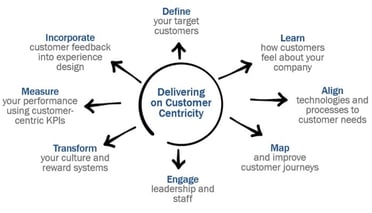If your organization has done any thinking about customer centricity, you’ve likely read buckets about the importance of enabling strategies and tactics based on a deep understanding of your customers.
The core message of all this writing around “customer understanding” is pretty simple: this understanding must be centered both on what customers want and need, as well as their value as defined by the contribution each makes to the profitability of your company.

After all, it’s pretty darn hard to put your customer at the center of your organization if you don’t know who they are. Assuming you’ve at least begin the process of better understanding your customers along these axes,
I’d like to offer eight capabilities for you to consider along the way, as you continue to build momentum for customer centricity across your organization.
- Define your target customers, and understand their needs across each stage of your relationship lifecycle and their unique journeys as they interact with your company
- Learn how customers feel about interacting with your company by listening to them regularly, acting on what you learn, and incorporating insights into decision making
- Align your “below the line” technologies, data and processes with outside-in customer journeys, and leverage them to support customer objectives across channels and silos
- Map customer journeys and touchpoints across your lifecycle, and use them to identify and remove pain points and barriers to customer progression
- Engage executives, leadership and staff in making customer-centricity real by consistently communicating the importance of customer experience to all stakeholders
- Transform your culture and reward systems, by aligning around meeting customer needs, and reward employees (both formally and informally) for doing so
- Measure and improve organizational performance by using customer-focused KPIs, such as contributions to and/or quality of customer experience by segments and journeys
- Incorporate customer and employee ideas, feedback and insights into the ongoing process of experience design and delivery
The journey to customer centricity isn’t an easy one;
there will be many challenges along the way as you align objectives, rewards and recognition with customer needs. Which is why you’ll need to focus on developing critical new sets of capabilities, like these, to help redefine how you interact with and serve your customers.
Of course, the list above is at best a partial one. But it’s informed by over a decade of working with companies of different sizes across different industries, and is a sound start for any organization working to get closer to and create a “win-win” relationship with its customers.
This blog originally ran on CMO.com, where Michael Hinshaw writes the weekly “Get Customer-Centric” blog.

